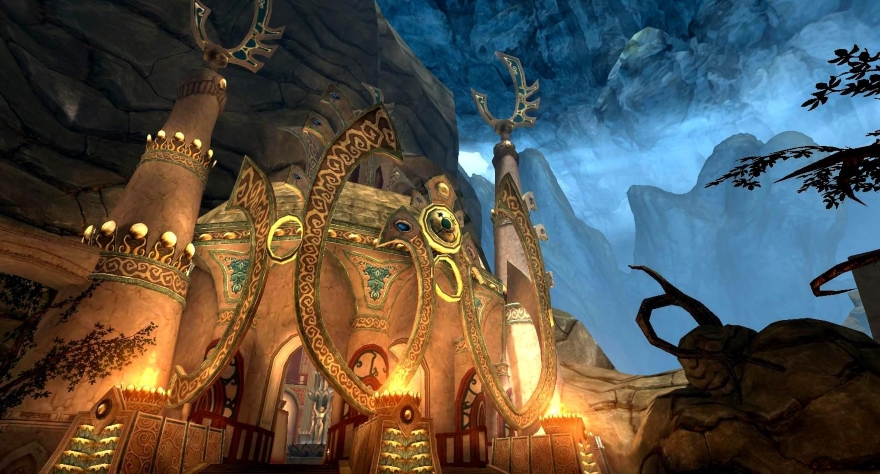
Hey! Hey you! Yeah, you the I’m-so-bored-with-all-of-these-MMOs gamer! You’ve been grousing about for years how MMOs never take risks, never innovate, and are merely content to rehash the same-old fantasy tropes that were stale even when World of Warcraft launched, right? Yes, we at Massively OP saw your poorly spelled Reddit post on that subject, thank you.
Well, what if I were to tell you that there’s an MMO that bucks the clichés? It’s true! Imagine an MMO that exists in a post-apocalyptic fantasy setting that’s unlike anything you’ve seen before. Imagine that combat isn’t merely hotbar button mashing but tactics mixed with positioning. Imagine that you can create your character to look any way you want from the onset instead of having to collect certain pieces of gear. Imagine an immersive world that is a delight to the eyes and ears.
Got all that? Want to play it? Well, you can’t. That game was The Chronicles of Spellborn, and since you and pretty much everyone else on the planet ignored it, it tanked in 2010 after less than a year of operation. Yet for its lackluster run, Spellborn has been strongly mourned by those who saw tremendous potential in it and who keep creating internet petitions to bring it back. Because petitions change everything. Today we’re going to take a look back at an MMO that took the path less traveled.

The promise of player freedom
In the mid-2000s, a small group of developers in Denmark were disatisfied with the current state of MMOs — and they decided to do something about it. The devs formed Spellborn NV, a studio that was dedicated to the singular purpose of making an online role-playing game that would buck the trends: The Chronicles of Spellborn.
Marketing and PR Manager Marco van Haren said that this project was a revolution against the status quo of fantasy MMOs: “Some of the current MMO conventions were thrown out of the window and replaced by our take on things. The end result is a big NO to Orcs, Elves and useless time sinks, and a big YES for player freedom and the emphasis on player skills.”
With a miniscule budget, an office full of passion, and a mid-size team of around 50 people, The Chronicles of Spellborn took shape. “We wanted to break away from the over used vanilla fantasy setting,” said Lead Game Designer Coen Neessen in 2010, “and we were really keen on making the combat more action-oriented and closer to an FPS rather than traditional MMORPGs.”
Even with this unique vision — or perhaps because of it — Spellborn NV had a devil of a time securing publishers who were willing to finance and promote the title. Eventually, Frogster agreed to handle Spellborn in Asia and some of Europe, Mindscape handled publishing for the rest of Europe, and Acclaim stepped in at the last minute to run it in North America.
The struggle to secure both publishers and finances took its toll on development, prompting the team to launch before it was fully ready. The Chronicles of Spellborn released in Europe on November 27, 2008, and in North America on April 23, 2009. North America’s launch was particularly troubled, as Acclaim hampered the subscription model with the unnecessary step of purchasing “Acclaim coins” at various rates to buy game time.
“It was hard for people to figure out just how much the game cost and whether or not they were getting a decent deal,” West Karana blogger Tipa wrote. Penny Arcade even jumped onto the controversial business model with a comic that spoofed the convoluted setup. At least there was a sort of unlimited free trial that allowed players to progress through the early zone before requiring a sub.
Unfortunately, the rocky launch and twisted business model would signal only the start of Spellborn’s troubles.

Survivors of the apocalypse
So what did The Chronicles of Spellborn do differently to elicit such strong testimonies from fans even today? For starters, the game’s setting wasn’t some idyllic generic fantasy country but a post-apocalyptic landscape where survivors lived inside “shards” of their former world a thousand years after the shattering. Between the shards was a magical Deadspell Storm through which intrepid adventurers could travel in order to reach the other remnants of society. Essentially, it was an entire game where you existed underground with nary an open sky in sight.
Players would pick from one of two races and one of three main classes before stepping into the role of a newbie militia member in the city of Hawksmouth. In a cool divergence from the standard, Spellborn allowed players to customize their character’s wardrobe from the get-go, allowing them to keep a certain look while swapping out sigils for stats. From there, they would need to go on quests, discover secrets of the world, and grow through nine sub-classes in order to become true heroes. There was even initial talk about time travel quests to go back to the world prior to the shattering, although those never came to be.
From the start, Spellborn simply looked, sounded, and felt incredibly dissimilar from other fantasy MMOs. Even compared to today’s titles, its Unreal Engine 2.5-powered graphics are quite evocative and stylized, with locales that were alien to the Tolkien crowd.
Perhaps the most controversial and unique aspect of the game was its combat system. Instead of the standard hotbar and tab-target fights, Spellborn used a skill deck to construct a “rotating hotbar” in which only (up to) five of a player’s skills were available at any one time. To both set up and use the hotbar properly required a bit of a learning curve, as it was possible to find yourself without moves in the middle of the game’s reticule combat. Adding to the controversy was Spellborn’s higher-than-average difficulty setting where fights would last longer than players encountered in other MMOs.
Another odd element of the game was how it divvied up experience. You got standard experience for finishing quests that went toward skills and levels, but combat also netted Personal Experience Points (PEP). PEP contributed to a persistent buff. Rise up in PEP levels, and your character would fight better. However, die once, and you’d lose an entire PEP level, decreasing your potency.

Abandoned to rot
As cool as Spellborn sounded on paper and much as it was revered by some portions of its playerbase, let’s be honest here: It had a string of lackluster launches and failed to catch on with the larger MMO community. It wasn’t an instant bomb, as it did garner some very nice reviews, but the title’s unique slant, higher difficulty level, bad launch decisions, and a lack of strong marketing wounded it deeply.
Two months after Spellborn released in North America, developer Spellborn NV announced that it was bankrupt. Acclaim stepped in to promise that the subscription title would be redeveloped as a free-to-play title: “The development is planned to carry into 2010 and will include several enhancements and changes to the current game.”
The Chronicles of Spellborn dropped its subscription and went completely free in August 2009, allowing players to enjoy the game while Acclaim and Frogster worked on what was now being dubbed “Spellborn Version Two.” While this gave hope to players for a future, it would be the last positive word that they would hear on the subject.
The publishers of Spellborn went quiet in the successive months, a period of uncertainty that was shattered when the MMO was abruptly shuttered in Japan during March 2010. Frogster followed this move by closing the title in the rest of Asia that June.
With the development team bankrupt and MIA, Spellborn was left to rot in the US. Acclaim silently abandoned its promise to convert the title to F2P, electing instead to merely keep the servers on while the website fell apart. By the summer, players could barely log into the game, as client downloads didn’t work from the main site and passwords often required resetting for each and every session.
Spellborn became a money sink that no company wanted. Acclaim sold the rights to Playdom, which promptly turned around and sold it to Disney. Frantic players tried to contact all three companies to see if there was anyone in charge who could help, but they were met with silence. That silence was broken to announce that the game would be shut down at the start of September, and after a false shutdown in mid-August, it went offline by the end of August 2010. Since then, all previously involved companies have been quiet on the game and no attempts by players to petition it back into existence have met with any success.
The end of the end of a world
It’s hard to argue that The Chronicles of Spellborn was a flawless masterpiece, but its proponents have championed it as an incredible effort despite its imperfections. Lead Content Designer Vincent Leeuw admitted that Spellborn was simply too ambitious with not enough resources to back those dreams up: “[It] tried to innovate on too many fronts at the same time.”
Could it come back? There’s a lot to say in favor of such a notion. Spellborn was beloved, it was unique, and it had immense potential. The thought of a resurrection makes one think that it would be sure cheaper than creating a new MMO from scratch, although serious improvements would have to be made. I would play it. Would you?
 Believe it or not, MMOs did exist prior to World of Warcraft! Every two weeks, The Game Archaeologist looks back at classic online games and their history to learn a thing or two about where the industry came from… and where it might be heading.
Believe it or not, MMOs did exist prior to World of Warcraft! Every two weeks, The Game Archaeologist looks back at classic online games and their history to learn a thing or two about where the industry came from… and where it might be heading.














